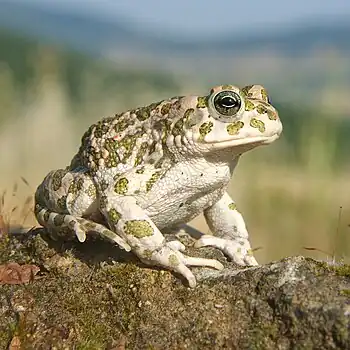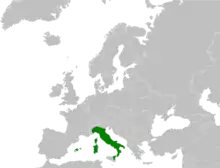| Balearic green toad | |
|---|---|
 | |
| Scientific classification | |
| Domain: | Eukaryota |
| Kingdom: | Animalia |
| Phylum: | Chordata |
| Class: | Amphibia |
| Order: | Anura |
| Family: | Bufonidae |
| Genus: | Bufotes |
| Species: | B. balearicus |
| Binomial name | |
| Bufotes balearicus (Boettger, 1880) | |
 | |
| Synonyms | |
|
Bufo balearicus Boettger, 1880 | |
The Balearic green toad (Bufotes balearicus) is a toad belonging to the true toad family, Bufonidae, from Italy and islands in the western Mediterranean Sea. It is mostly a lowland species, but can be found as high as 1,300 m (4,300 ft) asl in central Italy.[1]
Distribution
In spite of the name, this species is native to Italy (where it is present on all territories except for the extreme north-east, south-east and south-west) and Corsica.[1] It was probably introduced to the Balearic Islands in prehistoric times,[2] where it is common but declining.[1] Its formerly extended into Switzerland and there have been (so far) unsuccessful reintroduction attempts in that country.[3] Its range meets that of the similar and closely related European green toad (B. viridis) in far northeastern Italy and that of the Sicilian green toad (B. boulengeri siculus) in easternmost Sicily.[3][4]
Taxonomy and appearance
Once considered the same as the European green toad, molecular genetic data now firmly support its status as a separate species.[4][5] There is some hybridization where their ranges come into contact; hybridization with the Sicilian green toad is extremely limited.[3][6] The three species are very similar, but the Balearic green toad has paratoid glands with brownish or reddish spots.[3]
References
- 1 2 3 4 IUCN SSC Amphibian Specialist Group (2020). "Bufotes balearicus". IUCN Red List of Threatened Species. 2020: e.T153567A157692900. doi:10.2305/IUCN.UK.2020-3.RLTS.T153567A157692900.en. Retrieved 20 November 2021.
- ↑ Hemmer, Helmut; Kadel, Beate; Kadel, Karl (1981). "The Balearic toad (Bufo viridis balearicus (BOETTGER, 1881)), human bronze age culture, and Mediterranean biogeography". Amphibia-Reptilia. 2 (3): 217–230. doi:10.1163/156853881X00041.
- 1 2 3 4 Dufresnes, C. (2019). Amphibians of Europe, North Africa and the Middle East: A Photographic Guide. Bloomsbury Publishing. p. 77. ISBN 978-1-4729-4137-4.
- 1 2 Dufresnes, C.; et al. (2019). "Fifteen shades of green: The evolution of Bufotes toads revisited". Molecular Phylogenetics and Evolution. 141: 106615. doi:10.1016/j.ympev.2019.106615. PMID 31520778. S2CID 202573454.
- ↑ Stöck, M.; Sicilia, A.; Belfiore, N.; Buckley, D.; Lo Brutto, S.; Lo Valvo, M.; Arculeo, M. (2008). "Post-Messinian evolutionary relationships across the Sicilian channel: Mitochondrial and nuclear markers link a new green toad from Sicily to African relatives". BMC Evolutionary Biology. 8: 56–74. doi:10.1186/1471-2148-8-56. PMC 2276203. PMID 18294389.
- ↑ Colliard, C.; A. Sicilia; G.F. Turrisi; M. Arculeo; N. Perrin; M. Stöck (2010). "Strong reproductive barriers in a narrow hybrid zone of West-Mediterranean green toads (Bufo viridis subgroup) with Plio-Pleistocene divergence". BMC Evolutionary Biology. 10 (1): 232. doi:10.1186/1471-2148-10-232. PMC 2923517. PMID 20670415.
External links
 Media related to Bufotes balearica at Wikimedia Commons
Media related to Bufotes balearica at Wikimedia Commons Data related to Bufotes balearica at Wikispecies
Data related to Bufotes balearica at Wikispecies
